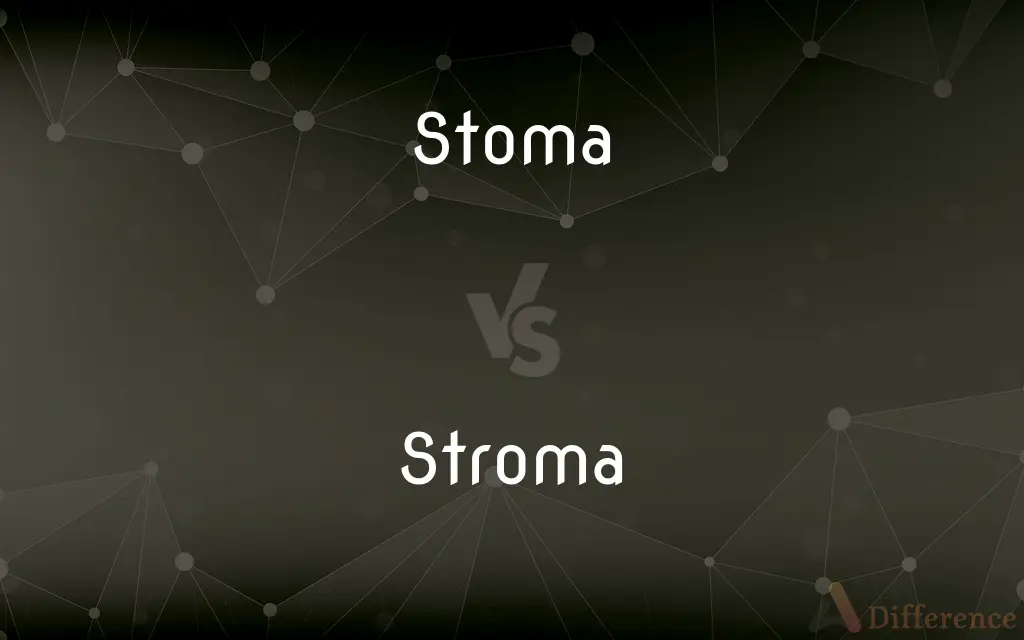Stoma vs. Stroma — What's the Difference?
By Fiza Rafique & Maham Liaqat — Updated on March 8, 2024
Stoma refers to a tiny pore on plant surfaces for gas exchange, while stroma is the supportive tissue of an organ, often seen in plants and animals.

Difference Between Stoma and Stroma
Table of Contents
ADVERTISEMENT
Key Differences
A stoma (plural: stomata) is a small opening, primarily found on the underside of plant leaves and some stems, facilitating gas exchange between the plant and its environment. It plays a crucial role in photosynthesis and transpiration. Stroma, in contrast, refers to the supportive framework of an organ or tissue, found both in plants and animals. In plants, it's the dense fluid within the chloroplasts where the light-independent reactions of photosynthesis occur.
Stomata are involved in the regulation of gas exchange and water vapor, directly influencing a plant's growth and health. The stroma in plants provides an area for important biochemical processes, including the Calvin cycle in photosynthesis.
Stomata consist of two specialized cells known as guard cells that control the opening and closing of the pore. Stroma, on the other hand, is the matrix or the fluid-filled interior of the chloroplasts, not surrounded by a specialized cell structure.
Stomata are found on the epidermis of leaves, stems, and other organs. Stroma is located within the chloroplasts in the cells of leaves and other green parts of the plant.
Stomata are specific to plant organisms, playing a key role in their respiratory and photosynthetic activities. Stroma, as supportive tissue, is found in both plants and animals, with its composition and function varying significantly between the two kingdoms.
ADVERTISEMENT
Comparison Chart
Definition
Pore on plant surfaces for gas exchange
Supportive tissue of an organ, or fluid in chloroplasts
Primary Function
Gas exchange and transpiration in plants
Support in tissues, photosynthesis in plant chloroplasts
Structure
Guard cells surrounding a pore
Tissue matrix or fluid inside chloroplasts
Location
Plant epidermis (leaves, stems)
Within organs or chloroplasts in plants and animals
Role in Photosynthesis
Allows CO2 in and O2 out
Site of light-independent reactions (Calvin cycle)
Compare with Definitions
Stoma
Comprised of guard cells that regulate its opening.
Guard cells swell to open the stoma, allowing for the exchange of gases.
Stroma
The supportive framework of an organ or tissue.
The stroma in animal tissues often consists of connective tissue.
Stoma
Essential for plant respiration and transpiration.
At night, stomata usually close to conserve water.
Stroma
Varies in composition between plants and animals.
Stroma in plants is involved in photosynthesis, unlike in animals.
Stoma
A tiny opening on plant surfaces for gas exchange.
The opening of stomata is crucial for photosynthesis to occur efficiently.
Stroma
In plants, it's the fluid inside chloroplasts where photosynthesis occurs.
The Calvin cycle takes place in the stroma of chloroplasts.
Stoma
Found primarily on the underside of leaves.
Stomata density can vary widely among different plant species.
Stroma
Essential for the functioning of chloroplasts in plants.
The enzymes for the light-independent reactions are found in the stroma.
Stoma
Influences a plant's water retention and gas exchange.
The stoma's opening and closing are responses to environmental conditions.
Stroma
The connective tissue framework of an organ, gland, or other structure, as distinguished from the tissues performing the special function of the organ or part.
Stoma
In botany, a stoma (from Greek στόμα, "mouth", plural "stomata"), also called a stomate (plural "stomates") is a pore, found in the epidermis of leaves, stems, and other organs, that controls the rate of gas exchange. The pore is bordered by a pair of specialized parenchyma cells known as guard cells that are responsible for regulating the size of the stomatal opening.
Stroma
The colorless semiliquid material inside a chloroplast, in which the thylakoid membranes are embedded and where the dark reactions of photosynthesis occur.
Stoma
Any of the minute pores in the epidermis of the leaf or stem of a plant, forming a slit of variable width which allows movement of gases in and out of the intercellular spaces.
Stroma
A dense mass of fungal hyphae on or in which reproductive structures develop.
Stoma
An artificial opening made into a hollow organ, especially one on the surface of the body leading to the gut or trachea.
Stroma
(anatomy) The tissue structure of an organ, etc., that serves to support it.
Stoma
(Botany) One of the minute pores in the epidermis of a leaf or stem through which gases and water vapor pass. Also called stomate.
Stroma
The connective tissue or supporting framework of an organ; as, the stroma of the kidney.
Stoma
(Anatomy) A small aperture in the surface of a membrane.
Stroma
A layer or mass of cellular tissue, especially that part of the thallus of certain fungi which incloses the perithecia.
Stoma
A surgically constructed opening, especially one in the abdominal wall that permits the passage of waste after a colostomy or ileostomy.
Stroma
The dense colorless framework of a chloroplast
Stoma
(Zoology) A mouthlike opening, such as the oral cavity of a nematode.
Stroma
The supporting tissue of an organ (as opposed to parenchyma)
Stoma
(botany) One of the tiny pores in the epidermis of a leaf or stem through which gases and water vapor pass.
Stoma
(medicine) A small opening in a membrane; a surgically constructed opening, especially one in the abdominal wall that permits the passage of waste after a colostomy or ileostomy.
Stoma
(zoology) A mouthlike opening, such as the oral cavity of a nematode.
Stoma
An artificial anus.
Stoma
One of the minute apertures between the cells in many serous membranes.
Stoma
The minute breathing pores of leaves or other organs opening into the intercellular spaces, and usually bordered by two contractile cells.
Stoma
A minute epidermal pore in a leaf or stem through which gases and water vapor can pass
Stoma
A mouth or mouthlike opening (especially one created by surgery on the surface of the body to create an opening to an internal organ)
Common Curiosities
How does the stroma contribute to photosynthesis?
In plants, the stroma within chloroplasts is where the light-independent reactions (Calvin cycle) of photosynthesis take place, using CO2 to produce sugars.
What is the role of stroma in animal tissues?
In animals, the stroma refers to the connective and supportive tissue within organs, providing structure and housing blood vessels and nerves.
What is the significance of the stroma in plant chloroplasts?
The stroma provides the environment for the enzymatic reactions of the Calvin cycle, converting atmospheric CO2 into organic compounds like glucose.
How do environmental factors affect stomatal opening?
Factors like light, humidity, and CO2 concentration can influence the opening and closing of stomata, affecting a plant's gas exchange and water conservation.
What is the main function of a stoma in plants?
The stoma regulates gas exchange and water vapor between the plant and its environment, crucial for photosynthesis and transpiration.
How do guard cells function in the opening of stomata?
Guard cells control the opening and closing of stomata by changing their shape in response to environmental cues, allowing plants to regulate gas exchange and water loss.
Is stroma present in all plant cells?
As a supportive matrix, stroma is specific to chloroplast-containing cells in plants, where it plays a direct role in photosynthesis.
Can stomata be found in animal tissues?
No, stomata are specific to plants and certain microorganisms, facilitating gas exchange essential for their photosynthetic processes.
Do all plants have the same number of stomata?
No, the number and distribution of stomata can vary greatly among different plant species, influenced by their habitat and evolutionary adaptations.
Can the function of stroma in plants be compared to any animal tissue?
While the stroma in plant chloroplasts is specific to photosynthesis, its supportive role is analogous to the connective tissues in animals that provide structure and support to organs.
Share Your Discovery

Previous Comparison
Disinfectant vs. Detergent
Next Comparison
Excellent vs. SuperiorAuthor Spotlight
Written by
Fiza RafiqueFiza Rafique is a skilled content writer at AskDifference.com, where she meticulously refines and enhances written pieces. Drawing from her vast editorial expertise, Fiza ensures clarity, accuracy, and precision in every article. Passionate about language, she continually seeks to elevate the quality of content for readers worldwide.
Co-written by
Maham Liaqat















































